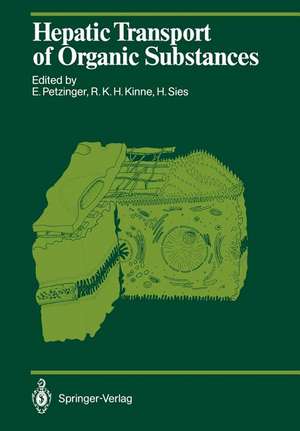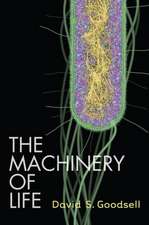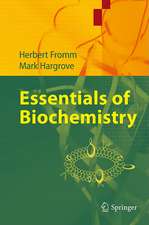Hepatic Transport of Organic Substances: Proceedings in Life Sciences
Editat de Ernst Petzinger, Rolf K. H. Kinne, Helmut Siesen Limba Engleză Paperback – 5 ian 2012
Din seria Proceedings in Life Sciences
- 15%
 Preț: 646.75 lei
Preț: 646.75 lei - 18%
 Preț: 952.26 lei
Preț: 952.26 lei - 15%
 Preț: 637.28 lei
Preț: 637.28 lei - 18%
 Preț: 960.61 lei
Preț: 960.61 lei - 15%
 Preț: 648.24 lei
Preț: 648.24 lei - 15%
 Preț: 632.70 lei
Preț: 632.70 lei - 15%
 Preț: 654.43 lei
Preț: 654.43 lei - 15%
 Preț: 635.80 lei
Preț: 635.80 lei - 18%
 Preț: 959.50 lei
Preț: 959.50 lei - 15%
 Preț: 650.37 lei
Preț: 650.37 lei - 15%
 Preț: 636.45 lei
Preț: 636.45 lei - 15%
 Preț: 644.49 lei
Preț: 644.49 lei - 15%
 Preț: 639.08 lei
Preț: 639.08 lei - 15%
 Preț: 641.53 lei
Preț: 641.53 lei - 15%
 Preț: 664.61 lei
Preț: 664.61 lei - 5%
 Preț: 721.77 lei
Preț: 721.77 lei - 15%
 Preț: 652.49 lei
Preț: 652.49 lei - 5%
 Preț: 592.63 lei
Preț: 592.63 lei - 15%
 Preț: 636.80 lei
Preț: 636.80 lei - 15%
 Preț: 646.43 lei
Preț: 646.43 lei - 15%
 Preț: 649.22 lei
Preț: 649.22 lei - 18%
 Preț: 1390.11 lei
Preț: 1390.11 lei - 18%
 Preț: 956.33 lei
Preț: 956.33 lei - 15%
 Preț: 643.48 lei
Preț: 643.48 lei - 15%
 Preț: 641.38 lei
Preț: 641.38 lei - 15%
 Preț: 642.03 lei
Preț: 642.03 lei - 15%
 Preț: 640.24 lei
Preț: 640.24 lei - 15%
 Preț: 649.39 lei
Preț: 649.39 lei - 5%
 Preț: 714.06 lei
Preț: 714.06 lei - 15%
 Preț: 640.37 lei
Preț: 640.37 lei - 15%
 Preț: 664.11 lei
Preț: 664.11 lei -
 Preț: 492.59 lei
Preț: 492.59 lei - 18%
 Preț: 945.47 lei
Preț: 945.47 lei - 15%
 Preț: 647.73 lei
Preț: 647.73 lei - 18%
 Preț: 942.01 lei
Preț: 942.01 lei - 18%
 Preț: 943.57 lei
Preț: 943.57 lei - 15%
 Preț: 639.41 lei
Preț: 639.41 lei - 5%
 Preț: 726.15 lei
Preț: 726.15 lei - 15%
 Preț: 641.03 lei
Preț: 641.03 lei - 5%
 Preț: 707.33 lei
Preț: 707.33 lei - 15%
 Preț: 647.27 lei
Preț: 647.27 lei - 15%
 Preț: 638.57 lei
Preț: 638.57 lei - 15%
 Preț: 645.79 lei
Preț: 645.79 lei - 15%
 Preț: 654.12 lei
Preț: 654.12 lei - 15%
 Preț: 652.31 lei
Preț: 652.31 lei - 18%
 Preț: 946.72 lei
Preț: 946.72 lei - 15%
 Preț: 637.28 lei
Preț: 637.28 lei - 5%
 Preț: 718.46 lei
Preț: 718.46 lei - 15%
 Preț: 653.33 lei
Preț: 653.33 lei
Preț: 651.34 lei
Preț vechi: 766.28 lei
-15% Nou
Puncte Express: 977
Preț estimativ în valută:
124.65€ • 129.66$ • 102.91£
124.65€ • 129.66$ • 102.91£
Carte tipărită la comandă
Livrare economică 14-28 aprilie
Preluare comenzi: 021 569.72.76
Specificații
ISBN-13: 9783642742491
ISBN-10: 3642742491
Pagini: 456
Ilustrații: XV, 435 p.
Dimensiuni: 170 x 244 x 24 mm
Greutate: 0.72 kg
Ediția:Softcover reprint of the original 1st ed. 1989
Editura: Springer Berlin, Heidelberg
Colecția Springer
Seria Proceedings in Life Sciences
Locul publicării:Berlin, Heidelberg, Germany
ISBN-10: 3642742491
Pagini: 456
Ilustrații: XV, 435 p.
Dimensiuni: 170 x 244 x 24 mm
Greutate: 0.72 kg
Ediția:Softcover reprint of the original 1st ed. 1989
Editura: Springer Berlin, Heidelberg
Colecția Springer
Seria Proceedings in Life Sciences
Locul publicării:Berlin, Heidelberg, Germany
Public țintă
ResearchCuprins
1 General Aspects of Hepatic Transport.- Glutamate-sodium Cotransport in the Kidney: An Example for the Plasticity of Transport Systems.- Energetic Coupling in Secondary Active Transport.- The Passage of Molecules into Bile: Paracellular and Transcytotic Pathways.- Increase in Paracellular Permeability as a Pathophysiological Principle of Drug-induced Intrahepatic Cholestasis in Rats.- The Hepatocyte’s Plasma Membrane Domains. Interrelations with the Endocytic Compartment.- Hepatic Spaces and Transport in the Perfused Liver.- New Methodologic Approaches for the Study of Transport in the Liver.- Transport Processes in Mammalian Gallbladder and Bile Duct.- Transcellular Butyrate Transport in Gallbladder Epithelium.- Accessibility of Primary Bile in Liver Cell Culture.- Polarity of the Hepatocyte Surface Membrane: Influence of Lipids on Protein Function.- ATP in and Around the Bile Canaliculus.- 2 Physiology, Pharmacology, and Biochemistry of Hepatic Transport Systems.- Hepatic Transport of Glutathione-Conjugates.- Glutathione Conjugate Transport in Hepatic Elimination of Electrophiles.- Hepatobiliary Cysteinyl Leukotriene Elimination.- Biliary Excretion of Thiols and Their Role in Elimination of Methylmercury.- Hepatic Transport of Amino Acids.- Glutamine and Glutamate Transport in Perfused Liver.- Regulation of Hepatic Amino Acid Transport and Partial Purification of the System A Carrier.- Hormonal Control of Amino Acid Transport Systems in Cultured Periportal and Perivenous Hepatocytes.- Differential Inactivation of System A in Normal and Transformed Liver Cells.- Mechanism of Renal Transport of L-Alanine in Luminal Membrane Vesicles.- Hepatic Transport of Organic Anions and Bile Acids.- Characteristics of Organic Anion Binding Proteins from Rat Liver SinusoidalPlasma Membranes.- Mechanism of Hepatic Fatty Acid Uptake.- Studies on the Mechanism of Organic Anion Transport by the Liver.- Mechanisms of Sinusoidal Bile Acid Transport.- Binding and Uptake of Taurocholate in Subcellular Organelles from Rat Liver.- The Ontogeny of Hepatic Bile Acid Transport.- Identification and Function of Bile Salt Binding Polypeptides of Hepatocyte Membrane.- Characterization of the Bile Acid Transport System in Normal and Transformed Hepatocytes Using Monoclonal Antibodies.- Transport of Bile Salts Across the Canalicular Plasma Membrane.- Biliary Taurocholate Excretion During the Metabolism of 2-Methyl-1, 4-Naphthoquinone (Menadione) in Perfused Rat Liver.- Comparison of Bile Salt-Binding Proteins in Basolateral Membranes from Small Intestine, Kidney, and Liver.- Effects of Hydrostatic Pressure and Liver Cell Membrane Potential on Hepatic Bile Acid Transport.- Characterization and Purification of Bile Acid Transport Proteins.- Transport of Taurocholate in Isolated Cells from Ileum, Liver and Kidney.- Properties of the Taurocholate Uptake System in Basolateral Rat Liver Plasma Membrane Vesicles: Effects of Albumin and Substrate Specificity.- Hepatic Transport of Xenobiotics.- Uptake of Foreign Cyclopeptides by Liver Cells.- Identification of Carrier Proteins in Hepatocytes by (Photo) Affinity Labels Derived from Foreign Cyclopeptides.- Uptake of Xenobiotics by the Bile Acid Transport System in the Liver: Relationship Between the Organic Anion Transport Systems in the Kidney and the Liver.- Mechanisms for Hepato-Bi1iary Transport of Cationic Drugs Studied with the Intact Organ and on the Membrane Level.- The Role of Liver and Extrahepatic Organs in the Metabolism of N-Nitrosodibutylamine (NDBA): Comparison of in Vitro with in Vivo Data.- The Roleof Biliary Excretion and Intestinal Metabolism for Toxokinetics and Toxicity of T-2 Toxin, a Major Trichothecene Mycotoxin.- Binding Proteins for Dipeptides, ?-Lactam Antibiotics, and p-Aminohippurate (PAH) in Plasma Membranes from Small Intestine and Kidney.- Hepatic Transport of Hormones.- Transport Properties of Steroid Glucuronides.- Intestinal Transport of Glucuronides and Sulphoconjugates.- Transport of Thyroid Hormone (TH) into Hepatocytes.- Metabolism of Thyroid Hormone in Liver.- Concluding Remarks.









